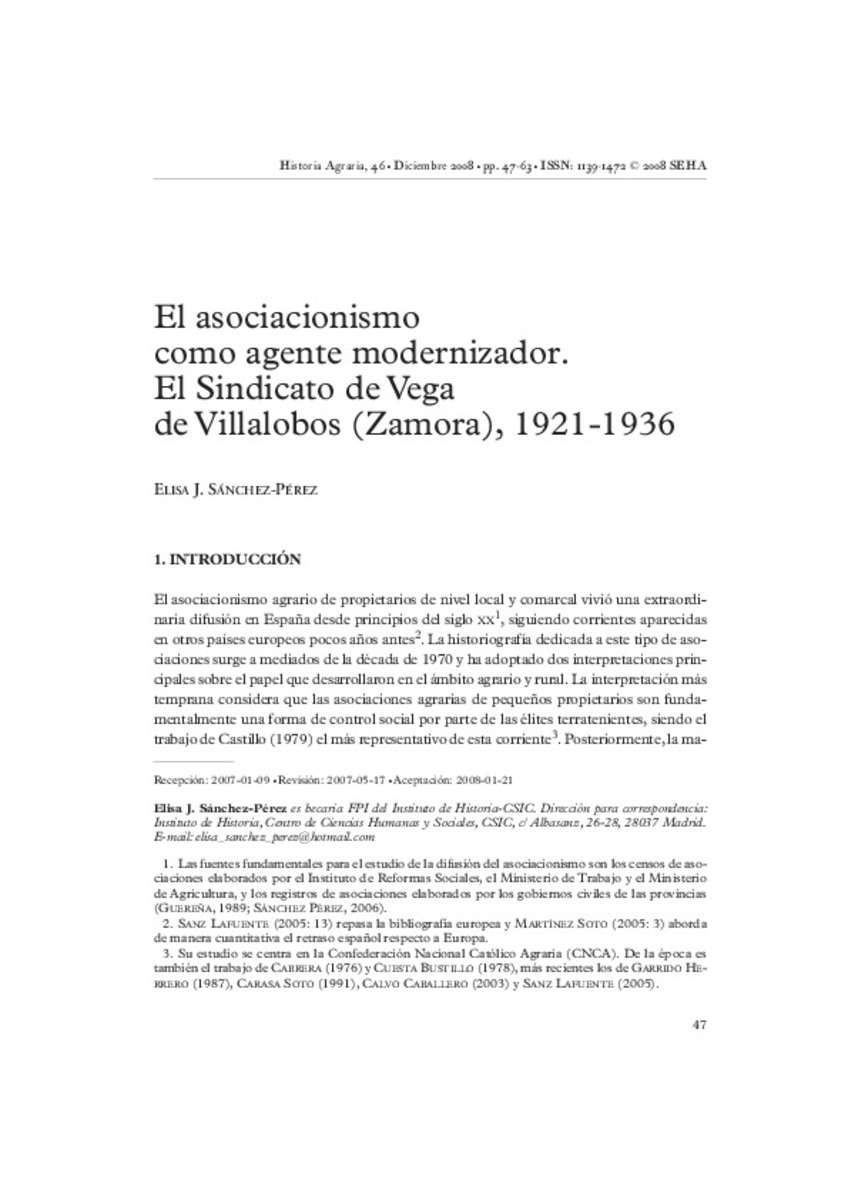Mostrar el registro sencillo del ítem
El asociacionismo como agente modernizador. El Sindicato de Vega de Villalobos (Zamora), 1921-1936
| dc.contributor.author | Sánchez-Pérez, Elisa J. | |
| dc.date.accessioned | 2016-01-22T13:33:49Z | |
| dc.date.available | 2016-01-22T13:33:49Z | |
| dc.date.issued | 2008-12 | |
| dc.identifier.issn | 1139-1472 | |
| dc.identifier.uri | http://hdl.handle.net/10234/146425 | |
| dc.description.abstract | En 1922 los socios del Sindicato Agrícola de Vega de Villalobos (Zamora) compraron cuatrocientas hectáreas de tierra de secano, transformando así la estructura de la propiedad del pueblo de manera radical. No hay noticias de que en aquel pueblo se hubiera llevado a cabo una operación de compra de tierras de tal magnitud en el pasado. Lo que diferenciaba aquella ocasión respecto a épocas anteriores era la existencia de una asociación que permitió a los agricultores del pueblo organizarse. La historiografía caracteriza el asociacionismo agrario de pequeños propietarios de principios del siglo XX como instrumento de las élites terratenientes o como mecanismo de modernización técnica de la agricultura. Con este estudio se defenderá la necesidad de considerar un nuevo factor: su capacidad de transformar las fórmulas organizativas y los sistemas de toma de decisiones en las zonas rurales. Las fuentes básicas de esta investigación son las actas del Sindicato y las entrevistas a informantes. | ca_CA |
| dc.description.abstract | In 1922 the members of the Sindicato Agrícola (Agrarian Association) of Vega de Villalobos (Zamora) bought a large extension of dry land. This purchase drastically changed the property structure of the village. There is no information about any other such important land transaction in the village. It was the existence of this Association what allowed the village farmers to organize themselves and buy the land. Historiography about agrarian associations of small landowners at local level at the beginning of the xx century describes this type of associations focusing on two aspects: the landowner elite’s use of them in order to exert social control, and the associations ability in the modernisation of the agrarian techniques. This study proposes the inclusion of a new factor in this characterisation: the capacity to transform the organisation forms and the collective decision-making in rural areas. The basic sources of this research are the Sindicato record together with interviews to informants. | ca_CA |
| dc.format.extent | 17 p. | ca_CA |
| dc.format.mimetype | application/pdf | ca_CA |
| dc.language.iso | spa | ca_CA |
| dc.publisher | Sociedad Española de Historia Agraria (SEHA) | ca_CA |
| dc.relation.isPartOf | Historia agraria: Revista de agricultura e historia rural, nº 46, p. 47-63 | ca_CA |
| dc.rights | © 2008 SEHA | ca_CA |
| dc.rights.uri | http://rightsstatements.org/vocab/InC/1.0/ | * |
| dc.subject | asociacionismo | ca_CA |
| dc.subject | capital social | ca_CA |
| dc.subject | sindicalismo católico agrario | ca_CA |
| dc.subject | toma de decisiones colectivas | ca_CA |
| dc.subject | estructura de la propiedad | ca_CA |
| dc.subject | associations | ca_CA |
| dc.subject | social capital | ca_CA |
| dc.subject | agrarian catholic associations | ca_CA |
| dc.subject | analysis of collective decision-making | ca_CA |
| dc.subject | land ownership | ca_CA |
| dc.title | El asociacionismo como agente modernizador. El Sindicato de Vega de Villalobos (Zamora), 1921-1936 | ca_CA |
| dc.type | info:eu-repo/semantics/article | ca_CA |
| dc.subject.jel | D02 | ca_CA |
| dc.subject.jel | D71 | ca_CA |
| dc.subject.jel | N34 | ca_CA |
| dc.subject.jel | Q15 | ca_CA |
| dc.rights.accessRights | info:eu-repo/semantics/openAccess | ca_CA |
| dc.relation.publisherVersion | http://historiaagraria.com/info_articulo.php?id=470 | ca_CA |







